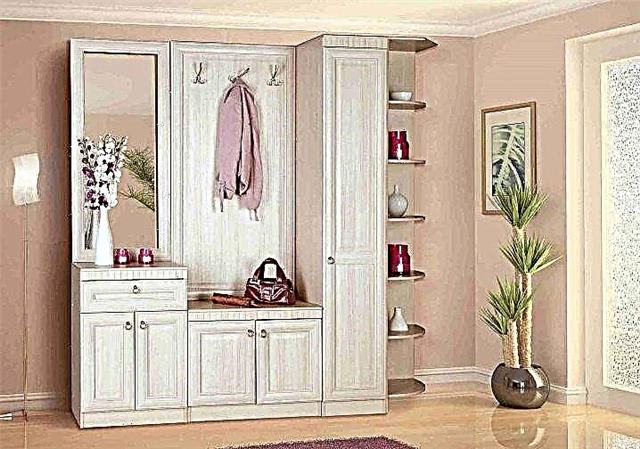Stretch ceilings perfectly complement the interior of the house - with the help of lightweight canvases, you can realize the most interesting ideas. Starry sky, tropical garden or parade of planets - fantasy has no limits. But how to care for modern ceilings? Detailed instructions: how to wash stretch ceilings at home without streaks.
1st method: manual vacuum cleaner
If there are no visible spots and impurities on the ceiling, but the canvas itself has become a little dull and dusty, then you can not wash the ceiling. It is enough to clean the glossy canvas with a hand vacuum cleaner. How to do it right?
- Take a vacuum cleaner with a small nozzle and wrap it with a soft cloth.
- Turn on the gentle mode and remove dust while holding the device a short distance so as not to suck the canvas.
- Gently vacuum the entire surface, paying particular attention to corners and connecting places.
3rd method: special solution
If the two previous methods are not suitable, then stretch ceilings can be washed with a home remedy. It’s easy to make: mix liquid soap or dishwashing detergent with ammonia and warm water. Wipe the entire sheet with a solution. To get rid of more corrosive spots, leave the solution for 20 minutes, and then rinse it off.
How to wash a glossy ceiling to make it shine? Finally, apply a solution of ammonia and water (1 to 9) over the entire surface and wipe it with a dry rag.
4th method: means for removing complex stains
- Fat and fat-containing substances - a soap solution from a dishwashing detergent and water will cope with the task.
- Traces of markers or felt-tip pens can be washed with plain water, if the markers are water-based, and alcohol-based, if alcohol-based.
- Rust and leaks - remove stains with soapy water and ammonia.
3rd method: combined cleaning
Combined cleaning is necessary for a comprehensive cleaning of the stretch ceiling. How to wash the matte ceiling at home? Here is a detailed action plan.
- Clean the ceiling surface with a soft, dry cloth or sponge.
- Use a dispenser to spray clean, warm water over the entire surface.
- Then apply detergent to either the entire sheet or to individual contaminated areas.
- Sponge the ceiling and remove cleaning agent and dirt.
- Using a hairdryer (in minimum mode), dry the dull sheet to prevent mold and mildew.
How to wash a suspended ceiling in a kitchen
Over time, drops of fat and moisture accumulate on the kitchen stretch ceiling. Do not delay washing kitchen ceilings to maintain the original appearance of the stretch ceiling. Basic rules for those who do not know how to wash the stretch ceiling in the kitchen.
- Use a soft cloth or sponge to prevent scratching the surface of the stretch ceiling.
- To eliminate greasy stains, you need to make a simple solution: mix the dishwashing detergent with water. It is important that the product is of low concentration.
- For glossy ceilings in the kitchen, you can use a non-aggressive window cleaner or a weak solution of ammonia with water.
- To avoid stains, do not wear too much. Gently wash excess with soft toilet paper or paper towel. And always clean the ceilings with perpendicular seam movements, rather than circular.
How to brush your teeth: the secrets of a beautiful smile
How to wash a stretch ceiling at home - a universal way
At home, manufacturers recommend washing the stretch ceiling only with special tools or a soap solution. In most cases, such cleaning is enough to clean the canvas from dust, construction dirt, greasy or nicotine deposits, soot. In this step-by-step instruction, we will talk about the universal and only method of cleaning, which is approved by manufacturers of tension structures.
- An ordinary mop with bristles, and preferably with a flat nozzle,
- Clean and soft microfiber rags or flannels (2 pcs.),
- A basin of warm water (but not hot!),
- Atomizer (optional)
- Liquid soap,
- For greater convenience, it is advisable to prepare a stepladder.
Our advice: It’s most convenient to wash the ceilings with a mop with a moving platform and a microfiber nozzle, which is also called telescopic (pictured). The price of such a mop is quite high - from 2 thousand rubles, but it is light, nimble and already has a nozzle that can be washed repeatedly.

Washing the stretch ceiling with a telescopic mop is more convenient and safer for the canvas than any other
Step 1. Dilute in a basin a mild soap solution of liquid soap and warm water. If you use a spray gun, then the following proportions are suitable: for 1 glass of water, 4 drops of liquid soap.
Step 2. Put on / put on a mop a rag dipped in soapy water (but not hot!) And proceed with cleaning. Start washing the stretch ceiling with a mop moving from one corner to another, systematically moving through the entire canvas. If the ceiling area is very large, then you can divide it into several sections, each of which should be washed moving from the walls to the center of the canvas.
- If you use a spray bottle, then you can evenly distribute the product in one section, then wash it by hand or with a mop with a clean, damp cloth. Next, move on to another site. The principle of movement of the mop is the same - from the walls to the center of the canvas.
Well, if you have a stepladder - it will allow you to manually remove local spots on the canvas, more cleverly wield a mop and better see dirt. Also a stepladder is needed if the ceilings are high.
- Avoid too much pressure so as not to rub dirt or dust into the web and damage it. Particular caution should be exercised when washing stretch ceilings installed close to the base (for example, at a level of 3-4 cm). In the latter case, it is better not to use a mop at all, but to wash the ceiling with your hands, climbing on a stepladder.

Washing ceilings with your hands is safer than using a mop
Step 3. If necessary, use one of the household or special products described in the next chapter to remove complex contaminants.
Step 4. If you wish, you can be safe from the appearance of stains and once again walk along the canvas with a mop with a clean damp cloth.
Step 5. After cleaning, be sure to wipe the stretch ceiling with a clean, dry cloth to get rid of the remnants of the product, and most importantly - from stains. In fact, this stage is polishing the canvas.
- For washing stretch ceilings, it is permissible to use only soft, lint-free rags (microfiber or flannel). Brushes and hard sponges should not be used.
- It is strictly forbidden to use cleaning products for washing ceilings containing: acetone, alkalis, solvents, chlorine, abrasive particles, as well as any washing powders, laundry soap, mustard, soda.
- Tensile structures must not be washed with hot water.
- If you plan to wash the ceiling by hand, be sure to remove the rings (especially with stones) from yourself before cleaning, so as not to damage the film.
How else to wash suspended ceilings
Despite the fact that manufacturers categorically do not recommend cleaning stretch ceilings with anything other than soap solution or special products (sold in hardware and construction stores, at stretch ceiling manufacturing companies), practice shows that sometimes they can be replaced:
- Window cleaner (based on ammonia) - this product is good because it allows you to wash stretch ceilings (except matte and fabric) without leaving stains. It also copes with greasy plaque and soot, local pollution. It is safest to use colorless liquids (without dyes in the composition).
- Dishwashing liquid - it is as neutral as soap, but it better copes with greasy coating, which is important for washing stretch ceilings in the kitchen.
- A solution of warm water and 10% ammonia (in a ratio of 9: 1) - suitable for washing only glossy and satin stretch ceilings (NOT suitable for matte ceilings!). They can effectively remove greasy and nicotine deposits, soot, food contaminants and splashes, as well as remove stains after the main cleaning. After applying the solution, the cloth must be wiped dry.
Before cleaning, test the cleaning agent in a small inconspicuous area. Apply it first, then wipe clean and dry. If after 10 minutes the treated area has not faded, faded, not deformed and remained without streaks, then the selected product can be used.

Detergent for suspended ceilings
How to clean matt, satin and fabric stretch ceilings?
- It is safest to clean fabric ceilings by dry cleaning (with soft cloths made of flannel / microfiber). It is permissible to use the vacuum cleaner in the mode of low retraction power (carefully). In this case, the nozzle must be kept at a distance of 3-5 centimeters from the canvas. If you need to clean stains and dirt, you can use the same mild soapy solution, treat it with a contaminated area and leave it for 5 minutes. The main thing is not to overdo it with friction, otherwise traces may remain.

You can also wash the fabric ceiling using a special tool as in the photo below.
How to wash the ceiling without streaks at home?
 Divorces are an eternal problem. No matter how clean the ceiling, their presence spoils the overall picture and gives the feeling that the cleaning was not carried out carefully enough. If in the room on the ceiling mainly dust accumulates, and getting rid of it at home is quite simple, then the kitchen is another matter.
Divorces are an eternal problem. No matter how clean the ceiling, their presence spoils the overall picture and gives the feeling that the cleaning was not carried out carefully enough. If in the room on the ceiling mainly dust accumulates, and getting rid of it at home is quite simple, then the kitchen is another matter.
No matter how often the room is ventilated, no matter how powerful the hood may be, soot settles on the surfaces of furniture and, especially, on the ceiling. Getting rid of him in the kitchen and bathroom is not easy, but possible. The main thing is to know what to do in order to simplify the task as much as possible. How to clean and renew the ceiling from soot and grease?
In the store you can buy specialized detergents that will greatly facilitate the cleaning process in the kitchen. Before washing, it is necessary to remove all jewelry (rings, bracelets) from hands so as not to accidentally damage the surface of the ceiling.
You can dilute detergent, dishwashing liquid, a solution with gel or regular soap. You need to make sure that there are no solid particles that could harm the ceiling. It can also be washed and bleached with a solution of ammonia (liter of water per 50 ml of alcohol).
 Use a soft cloth. Do not make circular movements, as they can cause divorces. You need to move from corner to corner. If there is a seam on the rag, it is necessary to wash along it, but not across. If we are talking about a light stretch ceiling, it is worth using a special microfiber cloth, which carefully removes dirt, dust and does not leave streaks of liquid.
Use a soft cloth. Do not make circular movements, as they can cause divorces. You need to move from corner to corner. If there is a seam on the rag, it is necessary to wash along it, but not across. If we are talking about a light stretch ceiling, it is worth using a special microfiber cloth, which carefully removes dirt, dust and does not leave streaks of liquid.
When planning to wash the ceiling at home in the kitchen from nicotine and yellowness, you need to prepare a stepladder, bucket, detergent, sponge or rag. Using a mop is not recommended, as some types of ceilings are not strong enough and can be damaged in the process. Hand-washing the ceiling is the safest option. After you wipe it with a soft, dry cloth.
Cleaning the tension model
Stretch ceilings are made of a fairly fragile material, so they should be washed only as they get dirty, without abusing detergents.
Regardless of the matte ceiling of the house, satin, glossy or black stretch, you should follow simple rules:
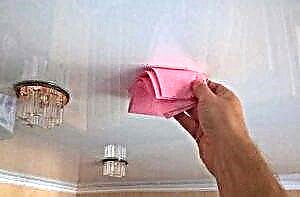 Only soft fabrics should be used: fiber or sponge. It is worth immediately abandoning the use of a mop, a scratching brush or a rag with a pile. Problems from them will be more than good.
Only soft fabrics should be used: fiber or sponge. It is worth immediately abandoning the use of a mop, a scratching brush or a rag with a pile. Problems from them will be more than good.- If you need to get rid of greasy stains at home, you can use the usual dishwashing detergent. If the ceiling is glossy, detergents for washing windows or mirrors, spray for glass surfaces are perfect.
- It is worthwhile to refrain from using powder products, sprays or solutions containing acetone. They can damage the surface and greatly spoil the appearance of the ceiling.
- If there are grease stains on the ceiling, it is necessary to moisten a rag in a diluted dishwashing detergent and walk very carefully through the stains, eliminating them with light movements.
- Stretch ceilings do not accept frequent washing. If you need to get rid of dust, just walk with a damp fiber cloth in the case of a dull ceiling. Or dry if it's glossy.
- If you wipe the glossy ceiling with a rag soaked in a solution of alcohol with water in a ratio of 1 to 10, this will help give it a shine. If the ceiling is dull at home, then you should refrain from using alcohol-containing products, as this can greatly damage the surface. In more detail, the process of cleaning the ceiling from pollution can be seen in the photo and video on the Internet.
Painted ceiling
It is worth noting that the ceiling painted with oil and acrylic paint is easier to wash at home. It is difficult to find a cleaning agent that can harm this coating. However, this type of ceiling is used less and less, as in modern residential buildings it is customary to use Tex emulsion paint.
If it is necessary to wash the ceiling painted with Edelweiss water-based emulsion, the following rules will help to do this as quickly and efficiently as possible:
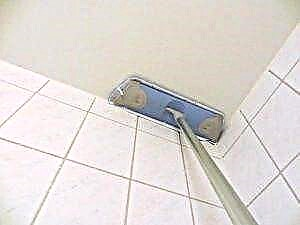 It is not recommended to use a mop or a hard brush, where it will be safer and more effective to wash with a rag.
It is not recommended to use a mop or a hard brush, where it will be safer and more effective to wash with a rag.- If there is a need to get rid of stains, it is better to use a soap solution or a mild detergent, since with them the least chance of damaging the surface.
- Before proceeding with wet cleaning, it is worth starting to try to go with a vacuum cleaner to remove possible gray deposits and dust spools.
- If the ceiling is just getting ready for painting, you need to make sure that there is no dust and dirt on it. If there is one, vacuum it first, or sweep it off with a special panicle, then wash it with a damp cloth and dry it. If there are irregularities on the ceiling, it makes sense to process it with putty in order to achieve the most even surface.
Outboard Model Care
Armstrong suspended ceiling is a rather interesting solution that looks great in almost any interior and medical facility. There are two types: hard and soft, the pros and cons can be read on the Internet. If with a hard ceiling you can hardly be afraid of damage, then with a soft ceiling you should be careful.
To wash the washable suspended ceilingArmstrong at home, you need to choose a product that does not contain acetone, since there is a chance that it will only harm the material. There are specialized tools for cleaning such ceilings. Although their price is higher, they can cope with pollution much better.
 You can use a tool for washing glass surfaces and PVC products, which include ammonia. This option will help to qualitatively clean the ceiling, and thanks to alcohol, there will be no stains. Ordinary dishwashing detergent may also be suitable, unless it contains granules or abrasive particles.
You can use a tool for washing glass surfaces and PVC products, which include ammonia. This option will help to qualitatively clean the ceiling, and thanks to alcohol, there will be no stains. Ordinary dishwashing detergent may also be suitable, unless it contains granules or abrasive particles.
If the contamination is slight, you can simply wipe the surface with a damp cloth and then with a dry cloth. If the surface is very dirty, you should first go with a vacuum cleaner, remove debris, old gouache and cobwebs, and then wash the ceiling with a soft sponge dipped in detergent.Do not press too hard, as this can damage the hygienic Bioguard or Medicare suspended ceiling.
After the ceiling and baseboard are washed with a cleaning agent at home, it is necessary to rinse it with clean water. Then wipe dry and polish with a special tool: detergent for glass surfaces or a solution of ammonia.
How to wash a plastic ceiling?
 The ceiling made of plastic panels is one of the most convenient types for washing, since a variety of detergents can be used to clean it.
The ceiling made of plastic panels is one of the most convenient types for washing, since a variety of detergents can be used to clean it.
The ceiling can be washed with a normal soap solution, which is not difficult to do yourself. It is enough to add soap foam to hot water, and the universal detergent for the plastic ceiling is ready.
It can be problematic to wash the plastic ceiling with a rag, but it will be quite comfortable with a mop. You may need to repeat the procedure several times before you can achieve cleanliness.
Laundry soap is the best option, especially if it is an old model with a characteristic yellow color. This soap is natural and very effective for washing a plastic ceiling. Alternatively, you can use a dishwashing detergent or a solution with ammonia.
Other types of ceilings
 There are other types of ceilings that, although less popular, are still in demand. Among them there are: fabric, satin, wooden, rack, mirror, drywall, foam and tile ceilings. Basically, the washing process is quite similar, but there are slight differences.
There are other types of ceilings that, although less popular, are still in demand. Among them there are: fabric, satin, wooden, rack, mirror, drywall, foam and tile ceilings. Basically, the washing process is quite similar, but there are slight differences.
Care should be taken with a fabric ceiling. Its canvases are easily damaged, and it is rather problematic to restore. Sprays for cleaning glass surfaces will not work here. Circular movements will leave stains. If you need to wash the fabric ceiling, you should do this on your own or on your own. You can use an aqueous solution of powder. Satin ceilings are best cleaned with a soft sponge, flannel cloth, or other lint-free cloth.
The wooden ceiling can be washed with a soft brush. As a detergent, a soap solution is perfect, which then will need to be washed off with clean water. After washing, it is recommended to wipe the surface with a dry cloth. Rack ceilings, as a rule, it is enough to vacuum and gently wipe with a damp cloth or microfiber cloths.
Drywall ceiling is not recommended to be washed with water, because due to the characteristics of the material this can adversely affectOn him. In this case, it will be enough to carry out wet cleaning with a cloth slightly dampened in water. If you can do without it, then a vacuum cleaner or a soft brush for dust will do.
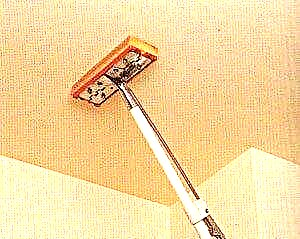 False mirror ceiling is the most difficult to maintain, because it has to be washed more often than others. Its surface is too sensitive to contamination, and they are clearly visible on it. Such a ceiling can be cleaned with a detergent for glass surfaces, and then wiped with a dry soft cloth so that there are no stains.
False mirror ceiling is the most difficult to maintain, because it has to be washed more often than others. Its surface is too sensitive to contamination, and they are clearly visible on it. Such a ceiling can be cleaned with a detergent for glass surfaces, and then wiped with a dry soft cloth so that there are no stains.
The foam ceiling can first be cleaned of dust with a vacuum cleaner, and then gently wash with detergent. Such surfaces can tolerate water without problems, but alkaline products are not recommended, as they can be harmful.
If the ceiling is glued with tiles, then you don’t have to worry about choosing a cleaning agent. Such specimens are not afraid of either water or chemicals. You can wash it thoroughly, and clean it with a copious amount of water, and simply wipe it with a damp cloth, or paint with Tikkuril or Dulux water-based paint, and the ceiling will look like new.
Detergents
Many housewives thought about how much it costs and how to wash the French ceiling from tobacco smoke or wash the dirty part of the ceiling above the window from tomato paste. Regardless of the finishing technology and what exactly needs to be washed, it is worth preparing it and choosing a cleaning agent that does not exactly harm the ceiling.
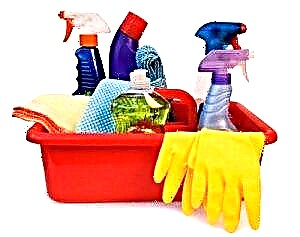 Cleaners containing acetone and abrasive products should be avoided.
Cleaners containing acetone and abrasive products should be avoided.- Ordinary soap solutions can be used for almost any type of ceiling.
- Another universal cleaning agent is microfiber cloth.
- They will cost more, but specialized sprays for cleaning ceilings, which include ammonia and antistatic, will give the best effect.
- One of the most popular detergents is Mr. Muscle and Vanish. Most cleaning companies use these cleaners during cleaning. They help clean the surface without damaging the material.
- Edelweiss (Edelweiss) - a lesser known tool, but an indispensable cleaner for glossy stretch ceilings. This tool is convenient in that it does not include caustic acids or alkalis, so that it is absolutely safe for the material. It is enough to apply the product with a spray, and then thoroughly wipe with a soft cloth.
- Another aerosol cleaner is Nouvel. Quite effective and at the same time safe. If you need to cope with traces of insects, remove cooking oil or smudges in the bathroom - this option is one of the best.
Common cleaning errors
Often, powder detergents are used to clean the ceiling, which causes the surface to suffer. Do not use them with acetone in the composition.
 It must be remembered that not all ceilings can withstand washing with a mop. If for a plastic version, a mop is an excellent tool, then it should not be used for a tension mop, since fragile material can be damaged.
It must be remembered that not all ceilings can withstand washing with a mop. If for a plastic version, a mop is an excellent tool, then it should not be used for a tension mop, since fragile material can be damaged.
Some ceilings, such as drywall, should not be washed with plenty of water. It would be much more useful to just walk with a damp cloth. It is not recommended to use hard brushes.
Do not wash the ceiling too often. If there is an opportunity to do with dry cleaning, then it is worth using it so as not to damage the coating. You can use a Karcher and a steam cleaner, but do it carefully.
Washing the ceiling is a difficult but necessary task. Following simple rules, you can clean the ceiling clean and not damage its surface. The main thing is to choose suitable detergents and act carefully.
How to wash stretch gloss
Through the efforts of masters, the old ceiling coating is transformed and turns into a perfectly smooth shiny surface. Satisfied owners are happy with such a transformation and are thinking about how to wash a glossy stretch ceiling without streaks at home and whether this can be done at all. We will analyze the important rules for the care of a film web.
Features of tension systems
Glossy ceiling coating is nothing more than a suspension system made of PVC film. The appearance and service life of the structure depend on the quality of the latter. The best option is a dense elastic material, which can also have any desired color. As a finish, photo printing is also possible. Before installing the panel, special fasteners are cut and welded along the edges.
On the walls are mounted profiles-baguettes, in which fasteners snap from the edges of the canvas. In order for this to be possible, the material is heated and stretched in this state. After cooling, it contracts slightly and stretches, forming a perfectly even coating. Thus, it is possible to close the unpresentable draft basis and all communications laid on it.
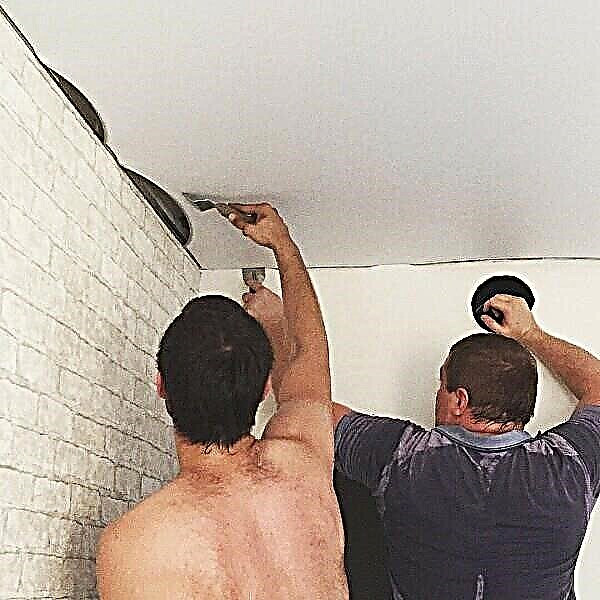
Pitfalls of cleaning
Possible maintenance difficulties are explained by design features. We will analyze them in detail.
- The blade is stretched over the frame, so it can be removed from the mounts. If the baguettes are fragile or the craftsmen made mistakes during installation, there is a chance that the film will be torn out of the latches. Such a probability is great when cleaning it with a vacuum cleaner, especially if it works at maximum power.
- The film is not sufficiently resistant to mechanical damage. Even dense and fairly durable material can be accidentally damaged, especially thin, low-quality. For this reason, do not put excessive pressure on the tool or press it with a hand with a rag. Elongated areas may appear. All rings, bracelets, etc. it is better to remove so as not to accidentally cut through the film.
- The shiny surface is afraid of abrasives. Like any other smooth finish, the glossy cloth can be scratched. As a result, noticeable stripes and scuffs appear that cannot be removed.
- The appearance of divorces. Gloss, like glass or mirrors, is very sensitive to detergent. Some of them, such as soap, leave marks on it. You can get rid of them only by completely removing the product, and this is not so simple. Therefore, the composition for cleaning should be chosen very carefully.
Other purely technical difficulties are possible. For example, if the ceiling is high, it is difficult to reach. In this case, you can take a mop, but optimally use a stepladder. Having stood on it, you can easily and safely wash any hard-to-reach area, while a mop can accidentally damage the cloth.
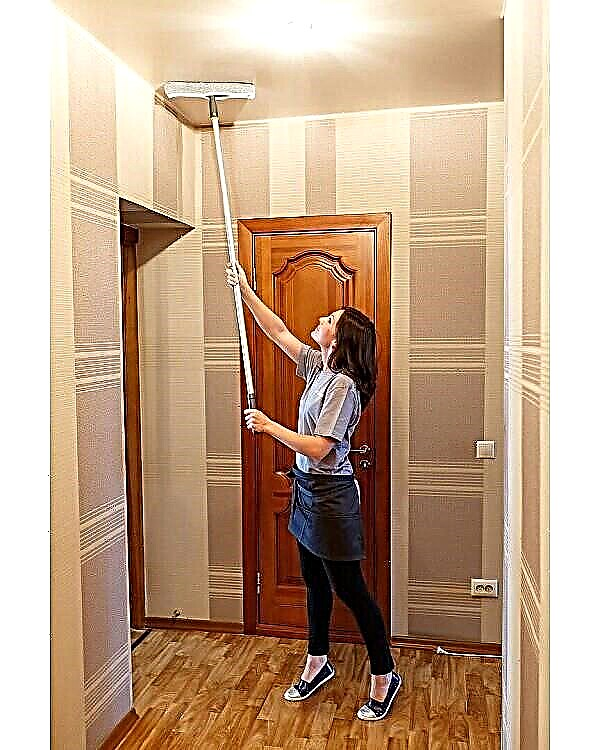
How often do I need to wash the coating?
The secret is always a clean and shiny ceiling in proper care. This does not mean that it must be constantly washed. Regular cleaning is suggested, and it does not always have to be wet. The main pollutant for gloss is dust. Other sources are added to the bathroom, kitchen or balcony. However, for most rooms, regular dry cleaning is indicated. If this is neglected, a layer of dust will fall on the gloss, which will only increase over time.
As a result, a brilliant canvas will fade and lose its color. If you clean it of dust from time to time, washing will be needed infrequently. Everything is different for rooms with difficult conditions. Particles of grease and soot are deposited on the kitchen floor, traces of foam and hard water, etc., are deposited in the bathroom. All this needs to be washed. It is optimal to remove stains immediately while they are fresh. In addition, wipe the entire surface as it gets dirty. And do it at least once every 6-10 months.

How to wash a glossy stretch ceiling
The right choice of drug and tools is very important, because the gloss is extremely moody in leaving. Let's start with the fixtures. Soft sponges for dishes and microfiber rags are very suitable for these purposes. A napkin made of natural wool may also be useful. It is electrified, so the dust does not scatter, but sticks to its surface. Of the suitable devices, telescope mops are well suited.
Such a cleaning tool will help reach every corner without using a stepladder. It is better to choose a nozzle from microfiber. It must be remembered that working with a mop should be very careful so as not to damage the cloth. In addition, it is advisable to stock up with paper towels, which will help remove stains and give shine to the surface.
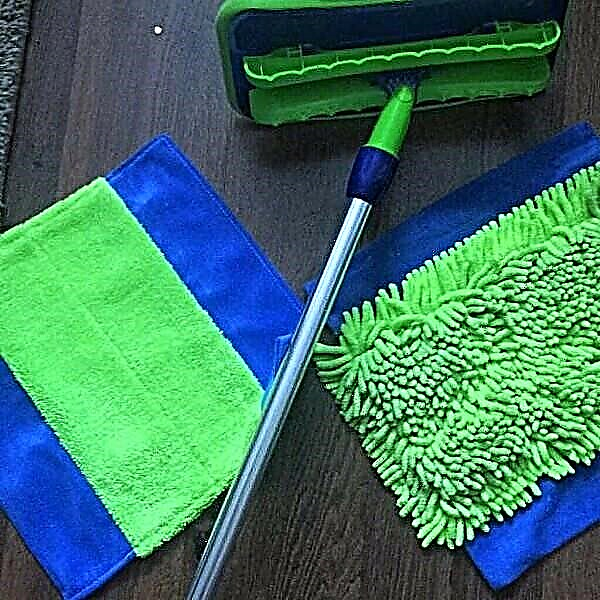
Let's move on to cleaning solutions. We have compiled a rating of funds, starting with those that give the best result to those that wash much worse.
Best remedies
- Special solutions for gloss. They are designed for gentle cleaning of the film from various contaminants. At the same time, you can be sure of their complete harmlessness to the canvas.
- Preparations for cleaning mirrors or glass. All kinds of alcohol-based products, available in the form of a spray. Alcohol perfectly dissolves pollution and does not give stains. Safe for film.
- Utensils A solution is prepared at the rate of 2 tablespoons per 5 liters of water. It effectively dissolves fat, so it will be a good solution to the problem than washing the glossy stretch ceiling in the kitchen. Leaves stains, therefore, requires repeated rinsing.
- Soap solution. For its preparation, soap shavings and water are used. It is worth taking neutral high-performance fragrance-free varieties. For example, children's or household. A small amount of chips should be completely dissolved in water. Leaves stains, especially on black panels. It requires rinsing.

It is worth listing the funds that can not be used categorically. These are all abrasives, even the lightest. They will scratch a smooth film, it will be impossible to fix it. In addition, all acetone-based formulations are prohibited. The latter discolors the film and adversely affects its structure. It can soften, wrinkles and creases appear. All aggressive acids and alkalis are also contraindicated.
1. Preparing the canvas
The first thing to do is to remove dust from the surface. Otherwise, when it comes into contact with water, it will turn into dirt, which will be rubbed along the cloth. Therefore, we begin cleaning with dry cleaning. It is good to use a microfiber cloth or wool for this, a mop with a similar nozzle is also suitable. If a vacuum cleaner is used, it must be set to minimum power.
2. Surface wash
Check if there are spots on the canvas. If so, we process them first. At home, you can use liquid for dishes or a saturated soapy solution. We apply the product and leave it for some time so that the substances that make up it can dissolve the pollution. After that, wash off the drug with clean water. If necessary, repeat the procedure. After we get rid of the stains, you can wash the entire surface.

We carefully spray the funds in the form of a spray onto the coating and wipe it with a paper towel. So guaranteed there will be no stains. If we use a soap solution, first prepare it for work, diluting it with warm, but not hot water. Then we foam the liquid. Wet the rag and wring it very well so that there are no drips on the gloss. Gently wipe the entire ceiling.
Here you need to adhere to some rules. No need to do circular motions, just straight. If there is a seam, you should move along, but never across. Otherwise, divorces will be especially noticeable. Large panels are processed in sections, moving from one wall of the room to another. If the surface is divided into sections, they are washed alternately. After applying a soap solution, it must be washed off with clean water. Then wipe the cloth dry.
Cleanliness Rules
In order to maintain a perfect appearance of a glossy panel for a long time, you should follow simple rules:
- Carry out dry cleaning regularly.
- If a spot is detected, remove it immediately; it is much more difficult to remove stubborn dirt.
- Put in the kitchen a properly selected hood, which will not allow a lot of soot and grease to be deposited on the ceiling.
- When cooking, cover the pans with lids to prevent grease from splattering.
It’s easy to take care of the film stretch ceiling. It is important to clean it of dust in time, to wipe off stains, then you will have to wash it much less often. At the same time, the canvas will retain its attractive appearance and shine for a long time. We offer you to watch a video about washing glossy designs.
Cleaning Features
The stretch matte ceiling fits perfectly into almost any interior. But various kinds of pollution can spoil any positive impression, even from the most sophisticated design. In addition, daily inhalation of dust does not contribute to better health. Although the canvas has an antistatic effect, but, like on any other surface, the dust will settle over time, and this effect does not save from other types of dirt.

Spray of champagne and soda, traces of the activity of various flies, lime condensate, soapy deposits, traces of soot, smoke and grease - these are not all the possible pollution of the ceiling. To wash them at home is completely within the power of any housewife. The main thing is to know the features of the material being cleaned.
Matte stretch ceilings are most often made of PVC film. Such material does not tolerate hard brushes, abrasives and rough handling. Too much force can cause cracks or even holes, in addition, the canvas can be inadvertently deformed. Such a surface cannot be cleaned with acetone-based products; an aggressive compound can “eat through” the coating.

There are several ways to clean the ceiling without streaks:
- Dry cleaning - the surface is wiped with a dry or slightly damp soft cloth, a special microfiber cloth. It is usually used when it is only necessary to brush off the dust.
- Dry cleaning with a vacuum cleaner - only use a special nozzle with a very soft pile.
- Wet cleaning - can be carried out both with plain water (the temperature of which should not exceed 40 degrees), and with the help of special solutions (purchased or made with your own hands).
- Steam cleaning - respectively, using a steam generator.

The surface of fabric ceilings is best cleaned with dry methods. When installing fabric webs, it is necessary to clarify whether such a coating is able to withstand wet cleaning. Not all fabrics used to decorate the ceiling are saturated with special compounds. And if you do wet cleaning of such ceilings, then you can inadvertently spoil the appearance of the coating.
How and what to wash?
It is not difficult to care for the matte ceiling if it is located in the living room, hallway, bedroom. Care of the canvas can be done once every few months, once every six months. Depending on the load of these rooms.
Another thing is the ceilings in the kitchen, bathroom. These rooms are characterized by increased “dirt accumulation”. Soaps, limescale - quite often you can see on the ceilings in the bathrooms. Traces of soot, grease remain on the surfaces of the kitchen. And unscrupulous smokers can leave reminders about themselves in the form of traces of burning, smoke.

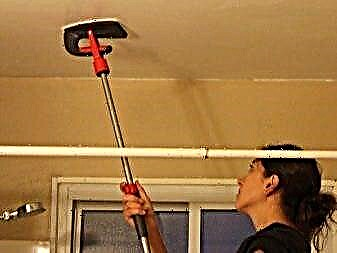
It is quite possible to clean the ceiling from any kind of pollution as improvised means, and specifically designed for these purposes. To do this, it is enough to wash the ceiling and wipe it dry so that there are no traces of stains.
Tools and Tools
Regardless of the degree of pollution of the ceiling, to clean it you will need:
- rags (cotton, for this purpose you can put old linen on rags) or napkins (they should be soft from non-woven lint-free materials, microfiber), soft sponges without a hard base,
- a good stable stepladder (or a stand that you certainly won’t fall from),
- when cleaning with a vacuum cleaner, the device must be equipped with a special nozzle with a soft pile,
- water, detergent or soapy water,
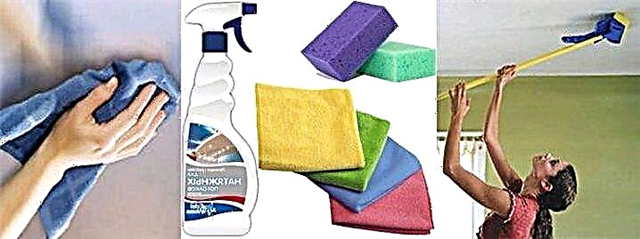
- atomizer - it can be used to facilitate the application of diluted detergents, if they are not presented in the form of aerosols or sprays,
- when using chemicals (even if they’re made in-house) gloves will not be superfluous, which are simply necessary if the person who is cleaning the surface has a wonderful manicure on long nails,
- mop - she should use it very carefully. Its working crossbar must be completely covered with a fabric that, if something doesn’t slip and fall,
- steam generator, if such cleaning is practiced.
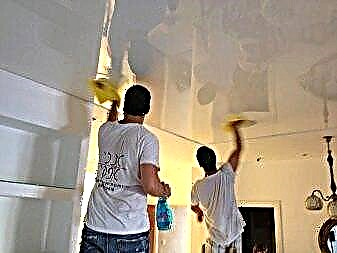

You can wash the stretch ceiling canvas even with ordinary water. It should be warm, but by no means hot! 40 degrees maximum. The temperature of any cleaning solution must not exceed this mark. You can enhance the effect of water with a dishwashing detergent or soap (not very alkaline, for example, for children).
When using products that dissolve well and form a rich foam, you can not wet the rags or sponges in the solution, but use foam. It will cope well even with old spots, and in terms of impact it will be less aggressive than the solution itself. So, for example, you can wash the matte cloth with foam from diluted laundry detergent. Take the powder for hand washing (“automatic” will not work for these purposes), whip into the foam using a mixer and apply to the surface.
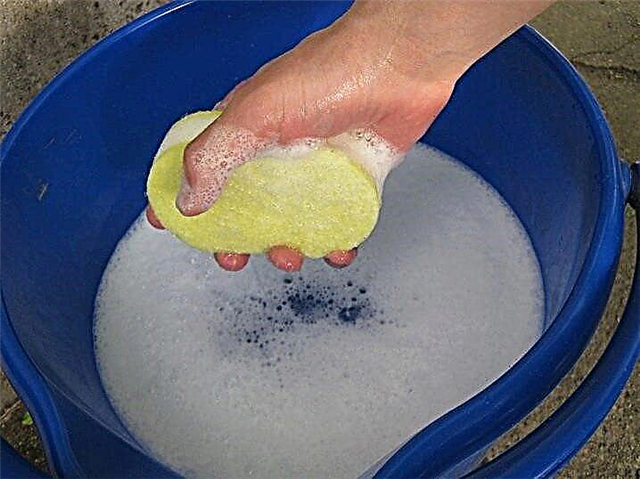
Tools for cleaning glasses and mirrors, especially those containing ammonia, have proven themselves well. Alcohol remarkably removes fat. Apply, wait about 15 minutes, then rinse and dry the surface. But when using glass cleaning products, you should always be attentive to the composition. If acetone is contained, then it should not be used categorically.
"Mr. Muskul", "Vanish" - have a rather gentle compositionwhich nevertheless perfectly removes dirt. And of course, in a hardware store you can buy a product specifically designed for cleaning stretch ceilings that cleans dirt, does no harm to the coating and does not leave stains.

Ways
Dust can only be removed from the mat with a dry, soft cloth. The main thing is to wipe the surface correctly when cleaning, without pressing too hard, do not rub with force. The ceiling is a structure made of frame and stretched fabric. If the exposure is too strong, the PVC film can deform - stretch into ugly stripes, wrinkles may form. Only professionals can fix this kind of defect.
When dry using a vacuum cleaner with a special nozzle, there is no need to bring the device close to the ceiling. It should be kept at a small, 1-2 cm distance.


When cleaning the ceiling with a steam generator, the instrument must be directed to contamination. Steam the surface, then immediately remove the condensation formed by wiping it dry.
When wet using a mop, you should also exercise extreme caution. If the fabric suddenly slips from the working crossbar, then trouble can not be avoided. The surface can be scratched. In addition, when using this tool, it is impossible to control the degree of exposure, as when working with a rag, sponge or napkin.
If the ceiling is cleaned by hand, then there should not be any jewelry on the hands, it is best to wear gloves. Often, for the treatment of the entire surface of the ceiling, several rags or napkins may be needed. Some to remove stains, others to dry and eliminate possible stains.

It’s better to clean the ceiling in fragments. One segment after another. It’s more convenient to move around, besides the canvas is always contaminated unevenly, somewhere a more thorough and painstaking effect may be needed, and somewhere just one movement of the hand with a damp cloth is enough.
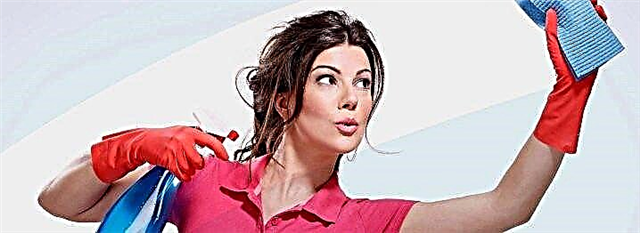
When there is a lot of pollution on the ceiling, general cleaning was not carried out or was already a long time ago, for example, several years ago, decisive action is needed.
The technology of deep web cleaning takes place in several stages:
- Dry clean first. The web is swept away from corners and fixtures, dust is removed.
- Then, a cleaning composition is applied to the surface.
- A certain time is expected. (If the dirt is very strong, so that the detergent works at full strength. If the spots are small, then you can go to the next step).
- The composition is washed off the canvas.
- Next is the drying. Wipe the surface with a dry cloth, a rag. To eliminate traces of soapy stains.

Useful Tips
In order to always delight the dull ceiling with its appearance, it is better to carry out dry cleaning regularly, and if stains occur, do not postpone their elimination for later, but immediately remove them while they are fresh and easy to clean.
For a drawing room, a hall, a bedroom and other rooms in which dirt does not accumulate so much, it is enough to carry out cleaning once every six months, a year.
Do not forget to ventilate the room where the suspended ceiling is installed.
All work is best done in the morning, when additional lighting is not required.
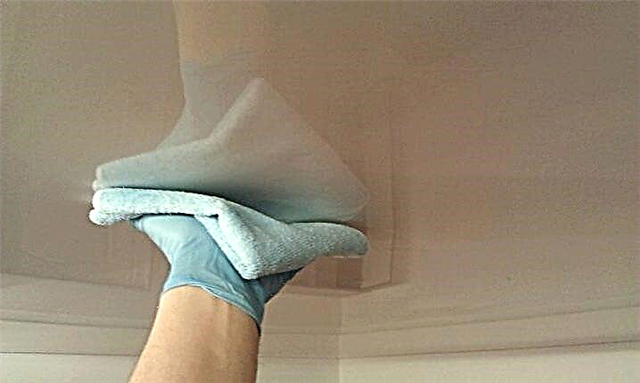
It is advisable to wash the suspended ceiling in the bathroom after each use. It is enough to remove condensate and soap deposits - wipe dry with a cloth. If such cleaning is not possible, then you need to take it as a rule - periodically do general cleaning in the room, starting from the ceiling.
Cope with fatty deposits will help funds, which include ammonia. Even despite the most powerful range hood, ceilings in the kitchen should be washed regularly and more often than, for example, in the living room. Dirt accumulates imperceptibly, but thoroughly.
Kitchen, bathroom, balcony - these are the most favorable places for the appearance of all kinds of pollution. Therefore, cleaning the ceiling here is more common.

Before cleaning, remove all jewelry from your fingers and wear gloves. This will protect the ceiling from small scratches, and hands - from the effects of chemistry.
If there is any doubt about how the cleaning composition will behave on the surface, then a preliminary test can be done. Apply the product somewhere in the “dark” corner of the room. Even if damage occurs, it will be imperceptible.
Often, stains remain after having gone too far with the detergent concentrate or forgot to wipe the cleaning composition from the surface and dry it. To eliminate existing soap strips, repeat the procedure for cleaning the ceiling using an aqueous solution of ammonia (dilute the product in a ratio of 1: 10).

The surface of the ceiling is best cleaned in segments. Along the seams. Straight lines. After cleaning, do not forget to walk along the canvas with a dry cloth. Such drying will protect from unnecessary stains.
Some types of contamination, such as discoloration of the canvas, cannot be eliminated with improvised means. This type of pollution can be attributed to yellowness on the kitchen ceiling. These color changes are due to exposure to hot steam. It is impossible to use any “bleaches” here. By the way, bleaching agents for cleaning stretch ceilings can not be used in any case.
Matte ceiling is a beautiful and important detail of the interior. And if you do not forget to clean it regularly, then it will last for many years, delighting you with its pristine beauty.
How to wash complex stains on a stretch ceiling, see the next video.

 Only soft fabrics should be used: fiber or sponge. It is worth immediately abandoning the use of a mop, a scratching brush or a rag with a pile. Problems from them will be more than good.
Only soft fabrics should be used: fiber or sponge. It is worth immediately abandoning the use of a mop, a scratching brush or a rag with a pile. Problems from them will be more than good. It is not recommended to use a mop or a hard brush, where it will be safer and more effective to wash with a rag.
It is not recommended to use a mop or a hard brush, where it will be safer and more effective to wash with a rag. Cleaners containing acetone and abrasive products should be avoided.
Cleaners containing acetone and abrasive products should be avoided.
